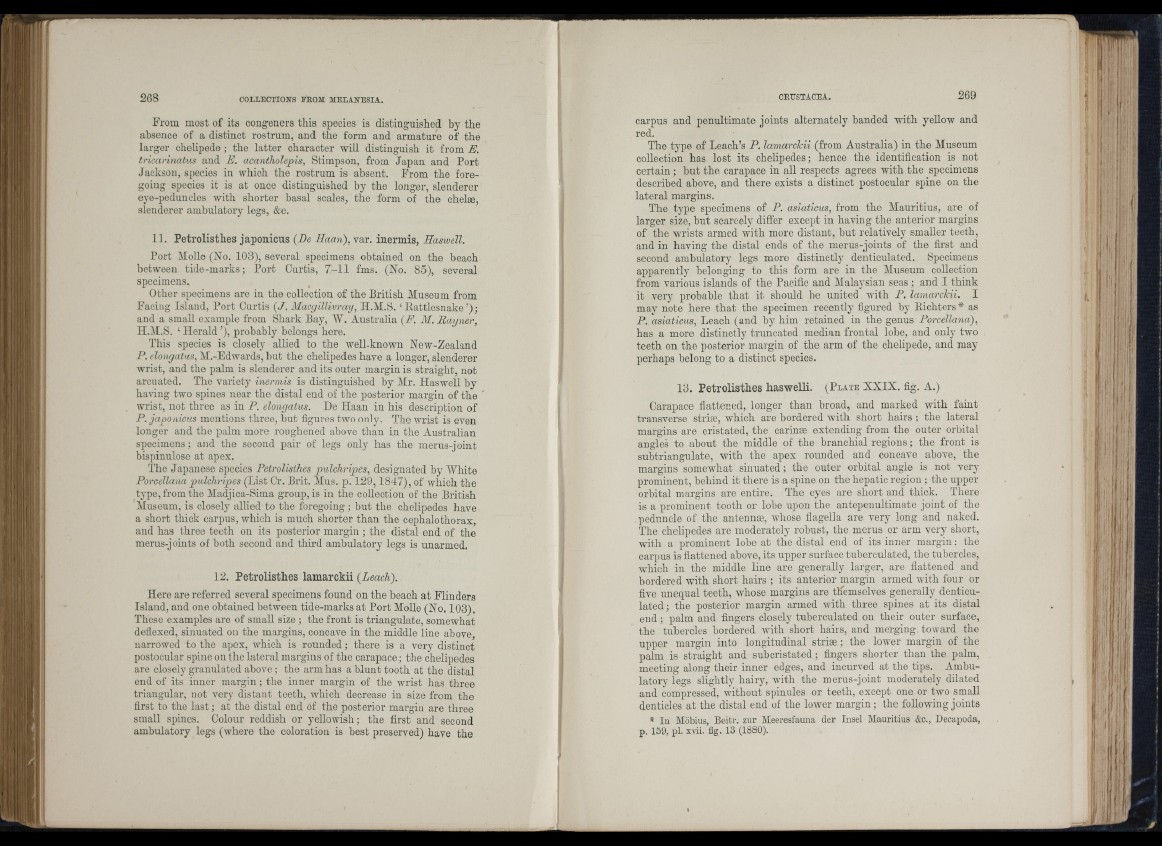
|S
î t
From most of its congeners this species is distinguished by the
absence of a distinct rostrum, and the form and armature of the
larger chelipede ; the latter character will distinguish it from E.
tricannatus and E. acantholepis, Stimpson, from Japan and Port
Jackson, species in which the rostrum is absent. From the foregoing
species it is at once distinguished by the longer, slenderer
eye-peduncles with shorter basal scales, the form of the chelæ,
slenderer ambulatory legs, &c.
11. Petrolisthes japonicus (De Haan), var. inermis, Haswell.
Port Alolle (No. 103), several specimens obtained on the beach
between tide-marks; Port Curtis, 7-11 fms. (No. 85), several
specimens.
Other specimens are in the collection of the British Museum from
Facing Island, Port Curtis {J. Alacgillivray, H.M.S. ‘Battlesnake’);
and a small example from Shark Bay, AV. Australia (F. AI. Bayner,
H.Al.S. ‘ Herald ’), probably belongs here.
This species is closely allied to the well-known New-Zealand
P. elongatus, Al.-Edwards, hut the chelipedes have a longer, slenderer
wrist, and the palm is slenderer and its outer margin is straight, not
arcuated. The variety inermis is distinguished by Air. Haswell by
having two spines near the distal end of the posterior margin of the
wrist, not three as in P. elongatus. De Haan in his description of
P. japonicus mentions three, but figures two only. The wrist is even
longer and the palm more roughened above than in the Australian
specimens; and the second pair of legs only has the merus-joint
bispiniilose at apex.
The Japanese species Petrolisthes piulchripes, designated by AVhite
Porcellana pulchripes (ListCr. Brit. AIus. p. 129,1817), of which the
type, from the Madjica-Sima group, is iu the collection of the British
Aluseum, is closely allied to the foregoing ; hut the chelipedes have
a short thick carpus, which is much shorter than the céphalothorax,
and has three teeth on its posterior margin ; the distal end of the
merus-joints of both second and third ambulatory legs is unarmed.
12. Petrolisthes lamarckii (Leach).
Here are referred several specimens found on the beach at Flinders
Island, aud one ohtained between tide-marks at Port Molle (No. 103).
These examples are of small size ; the front is triangulate, somewhat
defiexed, sinuated on the margins, concave in the middle line above,
narrowed to the apex, which is rounded ; there is a very distinct
postocular spine on the lateral margins of the carapace ; the chelipedes
are closely granulated above ; the arm has a blunt tooth at the distal
end of its inner margin ; the inner margin of the wrist has three
triangular, not very distant teeth, which decrease in size from the
first to the last ; at the distal end of the posterior margin are three
small spines. Colour reddish or yellowish; the first and second
ambulatory legs (where the coloration is best preserved) have the
carpus and penultimate joints alternately banded with yellow and
red.T
he type of Leach’s P. lamarckii (from Australia) in the Museum
collection has lost its chelipedes; hence the identification is not
certain ; hut the carapace in all respects agrees with the specimens
described above, and there exists a distinct postocular spine on the
lateral margins.
The type specimens of P. asiaticus, from the Mauritius, are of
larger size, hut scarcely differ except in having the anterior margius
of the wrists armed with more distant, but relatively smaller teeth,
and in having the distal ends of the merus-joints of the first and
second ambulatory legs more distinctly denticulated. Specimens
apparently belonging to this form are in the Museum collection
from various islands of the Pacific and Alalaysian seas ; and I think
it very probable th at it should he united with P. lamarckii. I
may note here th a t the specimen recently figured by Bichters * as
P. asiaticus, Leach (and by him retained iu the genus Porcellana),
has a more distinctly truncated median frontal lobe, and only two
teeth on the posterior margin of the arm of the chelipede, and may
perhaps belong to a distinct species.
13. Petrolisthes hasweUi. ( P l a t e XXIX. fig. A.)
Carapace fiattened, longer than broad, and marked with faint
transverse striæ, which are bordered with short hairs ; the lateral
margins are cristated, the carinæ extending from the outer orbital
angles to about the middle of the branchial regions ; the front is
subtriangulate, with the apex rounded and concave above, the
margins somewhat sinuated ; the outer orbital angle is not verj’
prominent, behind it there is a spine on the hepatic region ; the upper
orbital margins are eutire. The eyes are short and thick. There
is a prominent tooth or lobe upon the antepenultimate joint of the
peduncle of the antennæ, whose flagella are very long and naked.
The chelipedes are moderately robust, the merus or arm very short,
with a prominent lobe at the distal end of its inner margin ; the
carpus is flattened above, its upper surface tuberculated, the tubercles,
which in the middle line are generally larger, are flattened and
bordered with short hairs ; its anterior margin armed with four or
five unequal teeth, whose margins are themselves generally denticulated;
the posterior margin armed with three spines at its distal
end ; palm aud fingers closely tuberculated on their outer surface,
the tubercles bordered with short hairs, aud merging toward the
upper margin into longitudinal striæ ; the lower margin of the
palm is straight and subcristated ; fingers shorter than the palm,
meeting along their inner edges, and incurved at the tips. Ambulatory
legs slightly hairy, with the merus-joint moderately dilated
and compressed, without spinules or teeth, except one or two small
denticles at the distal end of the lower margin; the following joints
* In Möbius, Beitr. zur Meeresfauna der Insel Mauritius &c., Decapoda,
p. 159, pl. XYÜ. fig. 13 (1880).
• <
f